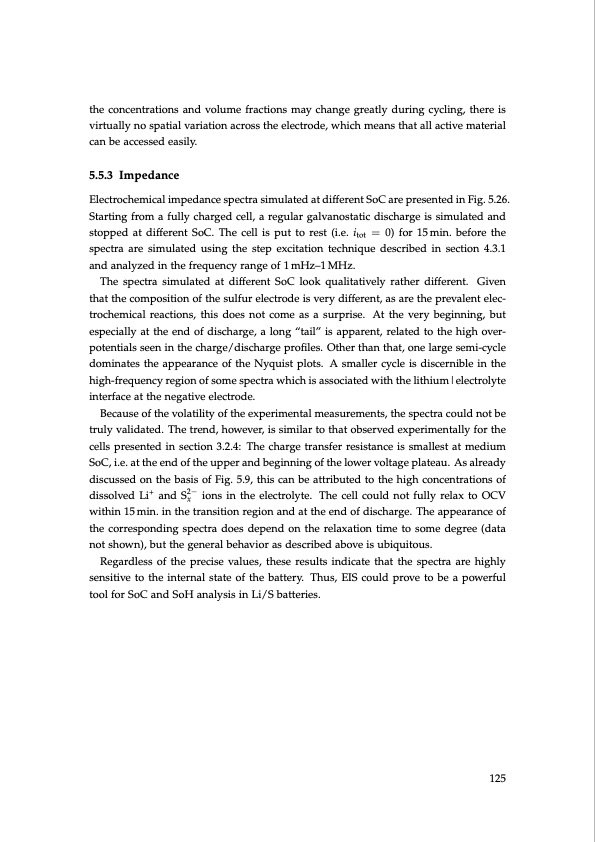
PDF Publication Title:
Text from PDF Page: 125
the concentrations and volume fractions may change greatly during cycling, there is virtually no spatial variation across the electrode, which means that all active material can be accessed easily. 5.5.3 Impedance Electrochemical impedance spectra simulated at different SoC are presented in Fig. 5.26. Starting from a fully charged cell, a regular galvanostatic discharge is simulated and stopped at different SoC. The cell is put to rest (i.e. itot = 0) for 15min. before the spectra are simulated using the step excitation technique described in section 4.3.1 and analyzed in the frequency range of 1 mHz–1 MHz. The spectra simulated at different SoC look qualitatively rather different. Given that the composition of the sulfur electrode is very different, as are the prevalent elec- trochemical reactions, this does not come as a surprise. At the very beginning, but especially at the end of discharge, a long “tail” is apparent, related to the high over- potentials seen in the charge/discharge profiles. Other than that, one large semi-cycle dominates the appearance of the Nyquist plots. A smaller cycle is discernible in the high-frequency region of some spectra which is associated with the lithium|electrolyte interface at the negative electrode. Because of the volatility of the experimental measurements, the spectra could not be truly validated. The trend, however, is similar to that observed experimentally for the cells presented in section 3.2.4: The charge transfer resistance is smallest at medium SoC, i.e. at the end of the upper and beginning of the lower voltage plateau. As already discussed on the basis of Fig. 5.9, this can be attributed to the high concentrations of dissolved Li+ and S2− ions in the electrolyte. The cell could not fully relax to OCV x within 15 min. in the transition region and at the end of discharge. The appearance of the corresponding spectra does depend on the relaxation time to some degree (data not shown), but the general behavior as described above is ubiquitous. Regardless of the precise values, these results indicate that the spectra are highly sensitive to the internal state of the battery. Thus, EIS could prove to be a powerful tool for SoC and SoH analysis in Li/S batteries. 125PDF Image | Lithium-Sulfur Battery: Design, Characterization, and Physically-based Modeling

PDF Search Title:
Lithium-Sulfur Battery: Design, Characterization, and Physically-based ModelingOriginal File Name Searched:
Dissertation_David_N._Fronczek_The_Lithium_Sulfur_Battery.pdfDIY PDF Search: Google It | Yahoo | Bing
Sulfur Deposition on Carbon Nanofibers using Supercritical CO2 Sulfur Deposition on Carbon Nanofibers using Supercritical CO2. Gamma sulfur also known as mother of pearl sulfur and nacreous sulfur... More Info
CO2 Organic Rankine Cycle Experimenter Platform The supercritical CO2 phase change system is both a heat pump and organic rankine cycle which can be used for those purposes and as a supercritical extractor for advanced subcritical and supercritical extraction technology. Uses include producing nanoparticles, precious metal CO2 extraction, lithium battery recycling, and other applications... More Info
| CONTACT TEL: 608-238-6001 Email: greg@infinityturbine.com | RSS | AMP |